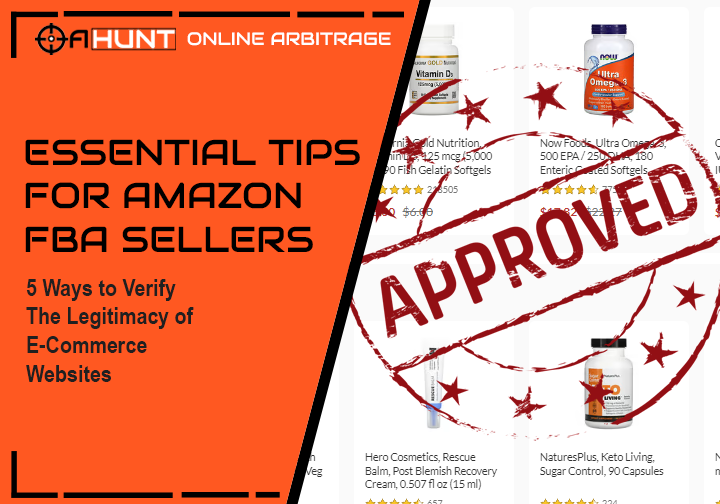When it comes to online arbitrage, there are a few different methods you can use to find products to sell. In this blog post, we will discuss one of those methods: manual sourcing. This involves stalking storefronts and doing google searches for products that other sellers have already listed on Amazon. While this method can be time-consuming, it can also be very successful if done correctly. We'll talk about the pros and cons of manual sourcing, and discuss the time savings of using a sourcing list versus doing this work yourself manually.
What Is Online Arbitrage?
Online arbitrage is the process of finding market discrepancies between online retailers and selling those products on Amazon for a profit. For example, you may find a product on Walmart.com that is selling for $25. You could then purchase that same product and sell it on Amazon for $60 and pocket the profits. To learn more about online arbitrage check out our article "What's Online Arbitrage? The Art of making money on Amazon in 2022"
The Cheapest Way to Source For Your Amazon Store
Manual online arbitrage is the cheapest way to get started selling on Amazon. This method takes more time than other methods but costs are kept low because of the need for very little software. You only need a calculator and Google to do this.
The other methods we'll discuss in other blog post series require the use of software that costs $$$. If you're just starting out, manual online arbitrage is the best way to keep your costs low and learn the ropes of online arbitrage before investing in any software.
How to do Manual Online Arbitrage
There are two main ways you can manually online arbitrage: reverse sourcing and retailer manual sourcing. We'll discuss both methods in detail below.
Reverse Storefront Sourcing
Reverse sourcing is the process of finding products that other sellers have already listed on Amazon and then finding those same products at a lower price elsewhere online. This is the most common method of manual online arbitrage because it is typically the most successful.
To reverse source, you will need to a storefront on Amazon, and Google to find products that are selling well on Amazon but are not sold by the brand themselves. Once you've found a product, add it to your watch list or "sourcing list" so that you can come back to it if it may be out of stock at the moment.
When you find a product that you think you can source for less than the current Amazon listing price, check the Keepa data to see what prices other sellers are selling the same product for as well as the history and trends related to the number of sellers and pricing. We'll discuss this more in a future article.
If the other sellers have similar prices to what you could source the product for, it's likely not worth your time to attempt to online arbitrage that particular product. However, if there are no other listings or the other listings have much higher prices, that is an opportunity for online arbitrage.
To find where you can source the product more cheaply than what it is currently selling on Amazon, do a Google search for "[product name]" This will bring up websites where you can purchase the product. From there it's all about doing the research and finding the supplier that may work best for you. One great tool that you might find useful for this is ASIN Gadget PRO. There's a "Google" button built right into it that will search Google OR Google Shopping for that product's title. You can find out more about ASIN Gadget PRO here
Retailer Manual Sourcing
The other method of manual online arbitrage is retailer manual sourcing. This is where you find products by starting at the retailer site (like Target, Bestbuy, etc...) that are selling for less than they are on Amazon and source them yourself from the retailer. This can be done by visiting retail websites or using online coupon codes to get products at a discounted price.
One great website for finding online coupon codes is RetailMeNot.com and rakuten.com These websites provide online coupon codes for a variety of retailers that you can use to get products at a discounted price.
For example, if you found a product on Amazon that you wanted to source from Target, you could do a search on RetailMeNot.com for "Target" and find online coupon codes that you could use to get the product at a discounted price.
Once you've found a product for less than what it is currently selling on Amazon, do the calculations and check the Keepa data to make sure it's a solid buy. I'm going to foot stomp this again *ALWAYS CHECK THE KEEPA DATA* to make sure there aren't a ton of other sellers currently selling the product, or that the price hasn't been dropping like a rock recently.
In Conclusion
Online arbitrage can be a great way to source products for your Amazon store, but it's important to be aware of the pros and cons involved. With a little practice, you'll be able to find the best deals and stock your store with products that will sell quickly and at a profit.
Manual online arbitrage sourcing is a great way to find products for your Amazon store, but it does have its drawbacks. The biggest advantage of manual online arbitrage is that it's relatively cheap to do. You don't need any fancy tools or memberships, just a computer, and an internet connection.
The biggest downside of manual online arbitrage is that it takes a lot of time to do. You have to spend time searching for products, checking prices, and doing the research to find suppliers. If you're not careful, it's easy to spend more time than you planned on online arbitrage and not make any sales.
Have you tried online arbitrage? What tips would you add? Let me know in the comment section below!
Happy Hunting!
Want more online arbitrage content? Here's a high quality video from my friend Josh over at EverDayFBA on YouTube!





Leave Comment Here
(Your email will not be shared with your comment)